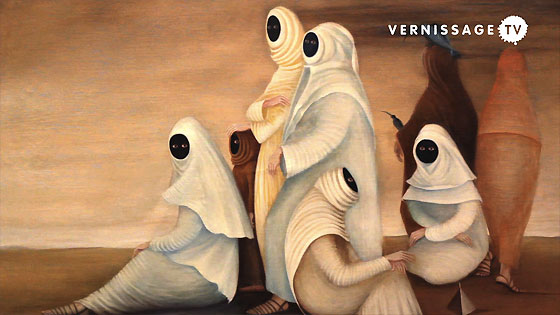
Let’s have a look at the work of Mexican Surrealist (yes, another one!) painter Bridget Bate Tichenor (1917-1990). If you had shown me the painting above before I knew about this artist, I definitely would have thought it was a Leonora Carrington piece.
Knowing that it is in fact by Bridget Bate Tichenor, the main difference between the two artists’ work for me is the spiritual feeling of their pieces. Both artists produced work with a profound spiritual presence, but Leonora’s seems more personal and delicate, whilst Bridget’s is comparatively universal and bold.
Needless to say, I love both! I really must go to Mexico one day – it clearly brings out the artist in a woman. I just need to figure out the coldest part and time of year…

Above: Portrait of Bridget Bate Tichenor by George Platt Lynes, New York 1945.
| Education | Slade School of Fine Art, École des Beaux Arts, Art Students League of New York |
|---|---|
| Known for | Painting, Fashion editor |
| Movement | Surrealism, magic realism |
|---|

Born in France and of British descent, she later embraced Mexico as her home… She was the daughter of the Virginia born American NBC, World War I correspondent Frederick Blantford Bate and Sarah (Vera) Gertrude Arkwright Bate Lombardi, who were married after Bridget’s birth in 1919. – Chisholm Gallery

Bridget Tichenor’s mother, who was reputedly a well-connected descendant of George III, was the public relations liaison to the royal families of Europe for Coco Chanel. After an arranged marriage Tichenor moved to New York, where she attended the Art Students League of New York. In 1945, after the divorce from her first husband, she married Jonathan Tichenor, an assistant of photographer George Platt Lynes. – Huffington Post

She was among a group of surrealist and magic realist female artists who came to live in Mexico in the late 1940s and early 1950s. Her introduction to Mexico was through a cousin she had first met in Paris in the 1930s: Edward James, the British surrealist art collector and sponsor of the magazine Minotaure. James lived in Las Pozas, San Luis Potosí, and his home in Mexico had an enormous surrealist sculpture garden with natural waterfalls, pools and surrealist sculptures in concrete. In 1947, James invited her to visit him again at his home Xilitia, near Tampico in the rich Black Olmec culture of the Gulf Coast. – Good old Wikipedia